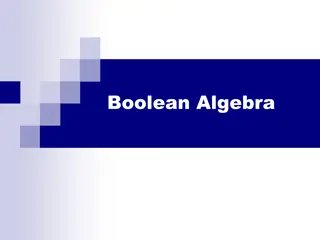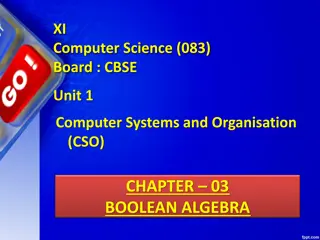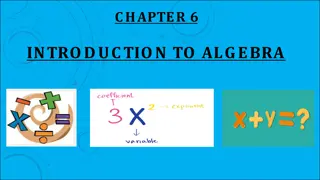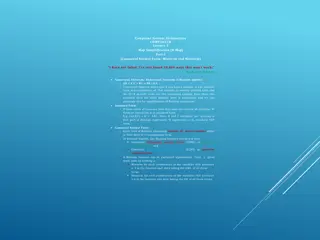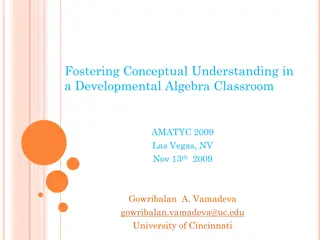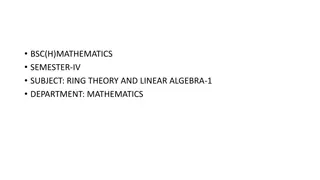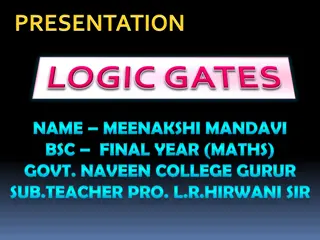Algebra Rules and Properties
Explore the fundamental rules and properties of algebra and indices, including commutative, associative, and distributive properties. Learn about negation, zero properties, and the zero factor property, illustrated with examples and common errors. Engage in activities to apply and test your understanding of these algebraic concepts.
Download Presentation

Please find below an Image/Link to download the presentation.
The content on the website is provided AS IS for your information and personal use only. It may not be sold, licensed, or shared on other websites without obtaining consent from the author. Download presentation by click this link. If you encounter any issues during the download, it is possible that the publisher has removed the file from their server.
E N D
Presentation Transcript
ALGEBRA: Rules of Algebra and Indices. 1.1 Let a, b, and c be real numbers, variables, or algebraic expressions. Algebra Properties (a) Commutative Property of Addition: a + b = b + a Example: x + x2= x2+ x Common Error x + x2= x3(???) (b) Commutative Property of Multiplication: Example: (3 x) x3= x3(3 x) ab = ba. (c) Associative Property of Addition: Example: (x + 2) + x2= x + (2 + x2) (3 + 2) + 42= 3 + (2 + 42) (a + b) + c = a + (b + c)
(d) Associative Property of Multiplication: Example: (2x . 5)(3) = (2x) (5 . 3) (ab) c = a (bc) (e) Distributive Properties: a(b + c) = ab + ac, (a + b)c = ac + bc. 2x(3 + 3x) = (2x . 3) + (2x . 3x) = 6x + 6x2, (y + 4)5 = (y . 5) + (4 . 5) = 5y + 20. Examples: (f) Additive Identity Property: a + 0 = a. (g) Multiplicative Identity Property: a . 1 = a. (h) Additive Inverse Property: a + (-a) = 0. (i) Multiplicative Inverse Property: a . 1/a = 1.
Remark: Because subtraction is defined as adding the opposite , the Distributive properties are also true for subtraction. For example, the subtraction form of a (b + c) = ab + ac is a(b c) = ab ac.
1.2 Let a, b, and c be real numbers, variables, or algebraic expressions. 1. (-1)a = -a. Example: (-1)6 = -6, (-1)5x = -5x. Properties of Negation 2. -(-a) = a. Example: -(-5) = 5, -(-y2) = y2. 3. (-a)b = -(ab) = a(-b). Example: (-3)4 = -(4 . 3) = 4(-3). 4. (-a)(-b) = ab. Example: (-2)(-x) = 2x. 5. -(a + b) = (-a) + (-b) = a b. Example: -(x + 3) = (-x) + (-3) = x 3.
1.4 Let a, b, and c be real numbers, variables, or algebraic expressions. Properties of Zero 1. 2. 3. a + 0 = a and a 0 = a. a . 0 = 0. = 0, a 0. a 0 a 4. is undefined. 0
5. If ab = 0, then a = 0 or b = 0 or both = 0. Zero Factor Property: Example: Common Error ) 1 = ( 1 x x = = 1 1 1 x or x = = 1 2 x or x Note: There could be many possibilities: 1 2 3 = = 2 ; 1 1 etc 2 3 2
Activity 1: Work in a group of 2. Complete the following tasks in 15 minutes. Do it on a piece of paper. Task 1: Give an example of Associative Property of Subtraction Task 2: Give an example of Zero Factor Property. Task 3: Choose all the correct choices 1. . 1 2 ( ) x = 2 2 2 2 ( ) . ( ) . ( ) . ( 1 )( ) x a b x c x d x 0 1 1 0 5 = + ( ) 5 0 ( . 0 ) b ( 0 ) c ( 0 ) d ( ) a e 2. 5 5 5 1 5 Task 4: Solve and . ) 3 )( 2 ( x x = ) 3 = 0 ( x x x
1.5 Properties and Operations of Fractions Let a, b, c and d be real numbers, variables, or algebraic expressions such that b 0 and d 0. 1. Equivalent Fractions: if and only if . 2. Rules of Signs: and . 3. Generate equivalent Fractions: , c 0. (Eg. = 2/4) 4. Add of Subtract with Like Denominators: . 5. Add of Subtract with Unlike Denominators: .
6. Multiply Fractions: . 7. Divide Fractions: , c 0. 1.6 Indices 52( 5 squared or 5 to the power of 2 ) and 43( 4 cubed or 4 to the power of 3 ) are example of numbers in index form. 54 = 5 5 5 5, 31 = 3, 32 = 3 3, 43 = 4 4 4 etc. The 2, 3 and 4 are known as indices. Indices are useful (for example they allow us to represent numbers in standard form) and have a number of properties.
1.7 Laws of Indices: Multiplication: Eg. x2 x5 = x7, 56 5-4 = 52 (because 6 + (-4)=6-4=2) x2 + x5 = x7 (???) Common Error an am = an+m. Division: Eg. 83 - 8-2 = 83-(-2) = 85 (???) Eg. (x3)2 = x6, an am = an/am = an-m. x3/x5 = x -2 , 83 8-2 = 83-(-2) = 85. Common Error Brackets: (an)m = anm. (42)4 = 48 (42)4 = 42+4 = 46 (???) Common Error
1.8 Anything to power 0 is equal to 1, i.e., Further Index Properties a0 = 1. 1 = n a Negative Indices: n a = 3 1 1 1 1 = = = 1 3 3 ( 2 ) 2 8 1= = 2 3 , x Eg. , 3 2 2 9 x 1.9 Fractional Powers: x1/n means take the n-th root of x. 4 364 Eg. 41/2 = , 641/3 = We can use the rule (an)m = an m to simplify complicated index expressions. Eg. (1/8)-1/3 =[(1/8)-1]1/3 =[8]1/3 =[23]1/3 = 2.
Exercises 1. (i) (ii) x2y7 x3y4 (iii) x3/y2 x6/y5 (iv) (x5/9y4/3)18 (v) (x1/5y6/5 z2/5)5 Simplify: (x3y5)4
2. 2.1 Factors of a Number Factorisation If a number can be expressed as a product of two whole numbers, then the whole numbers are called factors of that number. So, the factors of 6 are 1, 2, 3 and 6. Example: Find all factors of 45. Solution: So, the factors of 45 are 1, 3, 5, 9, 15 and 45.
2.2 Common Factors Example: Find the common factor of 10 and 15. 10 = 2 5 = 1 10 Factors of 10: 1, 2, 5 and 10. 15 = 1 15 = 3 5 Factors of 15 : 1, 3, 5 and 15. Clearly, 5 is a factor of both 10 and 15. It is said that 5 is a common factor of 10 and 15. Find a common factor of: a. 6 and 8 b. 14 and 21
2.3 Highest Common Factor The highest common factor (HCF) of two numbers (or expressions) is the largest number (or expression) that is a factor of both. Consider the HCF of 16 and 24. The common factors are 2, 4 and 8. So, the HCF is 8. Exe: Find the highest common factor of 60 and 150.
2.4 Highest Common Factor of Algebraic Expressions The HCF of algebraic expressions is obtained in the same way as that of numbers. Example:
2.5 Factorisation using the Common Factor We know that: a(b + c) = ab + ac The reverse process, ab + ac = a(b + c), is called taking out the common factor. Consider the factorisation of the expression 5x + 15.






